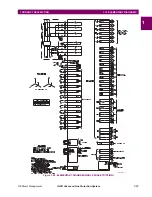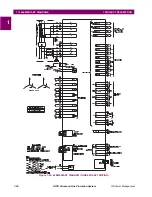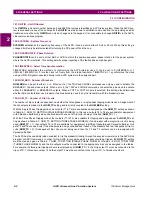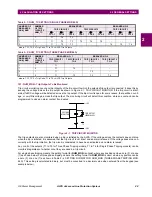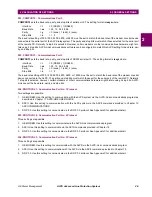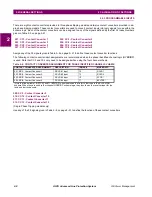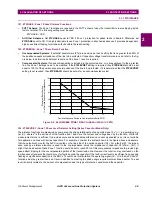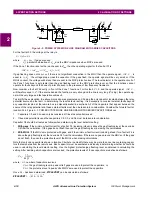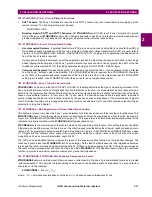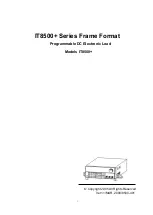
1-48
ALPS Advanced Line Protection System
GE Power Management
1.12 RECLOSER (OPTIONAL) 1 PRODUCT DESCRIPTION
1
c) RECLOSE IN PROGRESS (RIP) & LOCKOUT
This reclose in progress (RIP) output is produced whenever a reclosing cycle is started and it will reset when the recloser
goes to reset if reclosing is successful, or to lockout if reclosing is unsuccessful. The lockout output is be produced when-
ever the recloser is in the lockout state.
1.12.6 SYNCHRONISM CHECK (OPTIONAL)
An optional synchronism check function is available for use with the recloser. The synchronism check provides synchro-
nism check and/or voltage supervision of any or all three-pole reclosures. Protection Setting 1818: SYNCCHECK (range:
YES or NO) establishes whether the synchronism check function is to be used.
The synchronism check function requires voltage inputs from both the BUS and LINE side of the circuit breaker in order to
operate. The ALPS requires three phase potential for proper operation of its protective functions; this three phase voltage
may be supplied from either the bus or the line. In addition to this three phase potential, the synchronism check function
requires a single phase voltage from the other side of the breaker. This single phase voltage may be VA, VB, VC, VAB,
VBC or VCA. Setting 1821: BUSLINE (range: BUS or LINE) tells the recloser where the three-phase voltage used by the
relay system is located, bus or line. Setting 1822: SYNCPHASE (range: VA, VB, VC, VAB, VBC, or VCA) establishes which
phase or phase pair is used to make the angle and voltage check measurements.
In addition to the synchronism check supervision, this option includes voltage supervision. The three voltage supervision
modes are:
LBUSDLINE (live bus dead line); DBUSLLINE (dead bus live line); DBUSDLINE (dead bus dead line)
Four voltage Protection Settings (1832: VBUSLIVE, 1833: VBUSDEAD, 1834: VLINELIVE, and 1835: VLINEDEAD) are
required for the synchronism check to establish live and dead voltage levels for the bus and line potential. Each of these
levels has a range from 0.1 to 130 V. The live voltage setting for the line and bus also establish the minimum voltage that
must be present before the synchronism check functions are allowed to operate. Protection Setting 1819: CLOSEANG set-
ting establishes the angle that the BUS and LINE voltages must be within before reclosing will be permitted. In addition, the
slip frequency between the BUS and LINE voltages must be less than Protection Setting 1820: SLIPFREQ and both criteria
must be satisfied within the time specified by Protection Setting 1823: SYNCHOLD (range: 1 to 100 s). If the closing angle
and slip frequency requirements are not met before the SYNCHOLD time ends, then the recloser will go to lockout.
The synchronism check function also measures the difference in magnitude between the bus voltage and the line voltage.
If the delta voltage supervision is desired, Protection Setting 1840: DELTAVBLK is set to YES. Protection Setting 1839:
DELTAV establishes the maximum difference for which reclosing is allowed. If the voltage difference is greater than the
DELTAV setting, then reclosing will be blocked even if the bus and line voltages are within the angle established by the
CLOSEANG setting.
•
SYNCHRONISM CHECK INPUTS - The only additional input required to run the synchronism check function is the sin-
gle-phase voltage input. No contact inputs are required.
•
SYNCHRONISM CHECK OUTPUTS - The only output produced by the synchMho check function is the synchronism
check/voltage check permission output. This output is run directly to the internal recloser to supervise reclosing. The
output is also programmable, therefore, if an external synch check signal is required. it may be programmed to drive
one (or more) of the output contacts in the ALPS either through ALPS-Link, Xpression Builder, or the keypad.
1.12.7 ALPS RECLOSING PROGRAM SUMMARY
TRIPMODE
(SETTING 1203)
RECLTYPE
(SETTING 1802)
INITIAL TRIP
TYPE
PROGRAM
1POL/1POLZ2 1POLE Single phase Up to 4 reclose attempts using 1P delays
Three phase Lockout
3 POL 1POLE Any trip Lockout
3POL 3POLE Any trip Up to 4 reclose attempts using 3P delays
1POL/IPOLZ2 3POLE Any trip Lockout
1POL/1POLZ2 1POLE3POLE Single Phase Up to 4 reclose attempts using 1P delays
Three phase Up to 4 reclose attempts using 3P delays
3POL 1POLE3POLE Single Phase Up to 4 reclose attempts using 3P delays
Three Phase Up to 4 reclose attempts using 3P delays


















